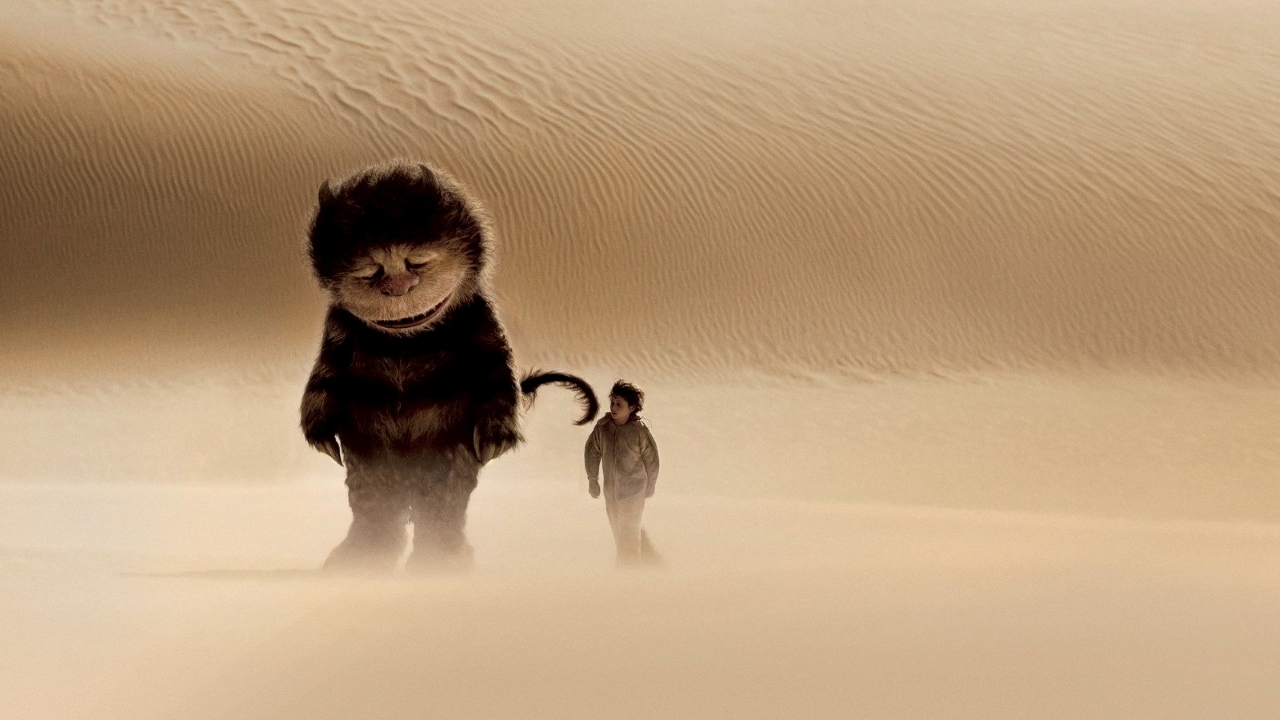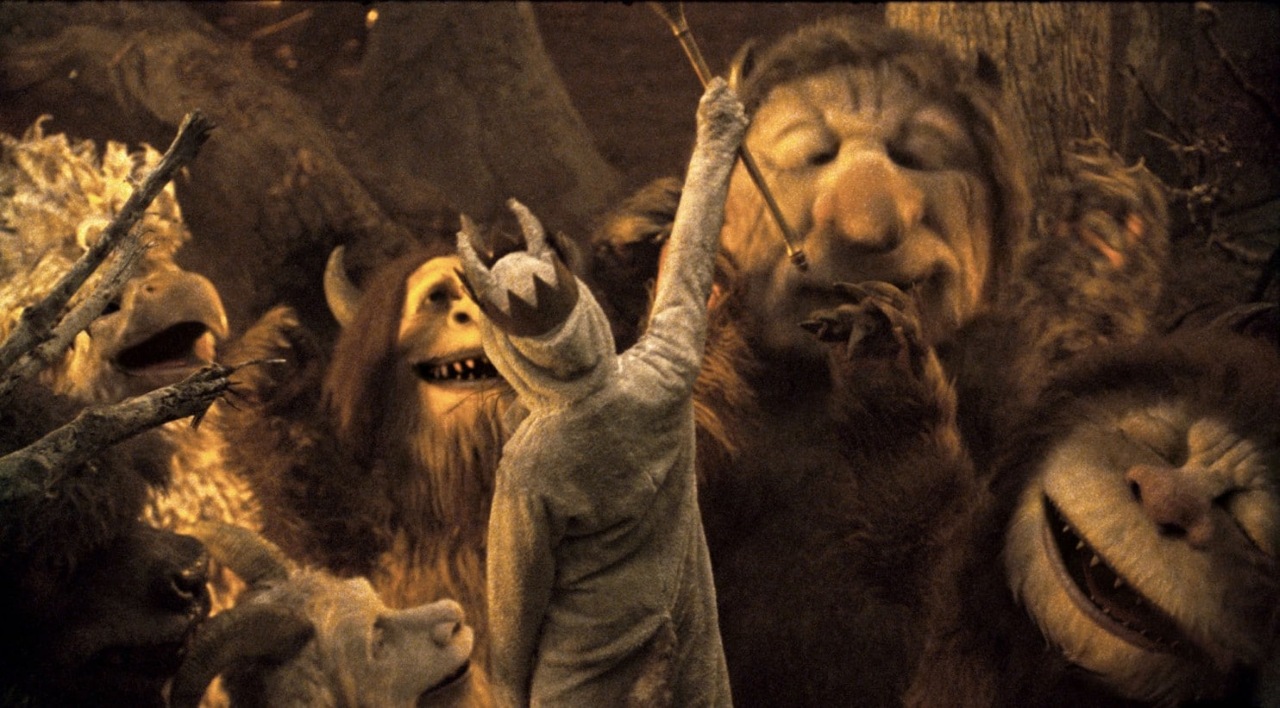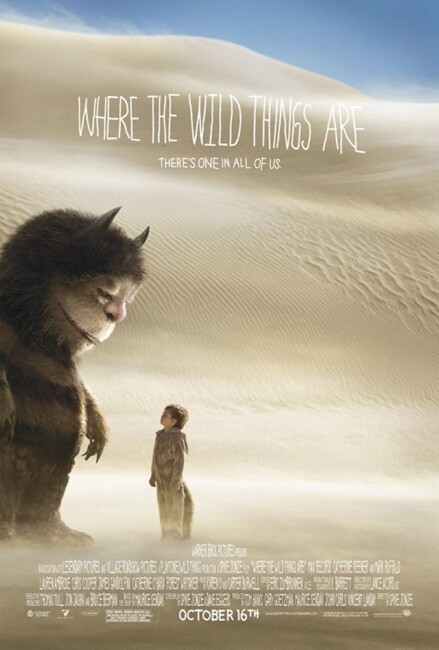Crew
Director – Spike Jonze, Screenplay – Dave Eggers & Spike Jonze, Based on the Book Where the Wild Things Are (1963) by Maurice Sendak, Producers – John Carls, Gary Goetzman, Tom Hanks, Vincent Landray & Maurice Sendak, Photography – Lance Acord, Music – Carter Burwell & Karen O, Visual Effects Supervisor – Daniel Jeannette, Animation Supervisor – Michael Eames, Visual Effects/Animation – Framestore, Additional Visual Effects – Iloura & Rising Sun Pictures, Special Effects Supervisor – Peter Stubbs, Animatronics/Creature Effects – Jim Henson’s Creature Shop (Supervisor – Peter Brooke), Production Design – K.K. Barrett. Production Company – Warner Brothers/Legendary Pictures/Village Roadshow/Playtone/Wild Things Pictures.
Cast
Max Records (Max), Catherine Keener (Mom), Pepita Emmerichs (Claire), Mark Ruffalo (The Boyfriend)
Voices
James Gandolfini (Carol), Lauren Ambrose (KW), Catherine O’Hara (Judith), Forest Whitaker (Ira), Chris Cooper (Douglas), Paul Dano (Alexander)
Plot
Young Max feels friendless and alone. After playing up and misbehaving in front of his mother, he runs away. He finds a boat and sets sail. Eventually, he comes to another land and goes ashore. Passing through a forest, he spies on a group of large, monstrous wild things. One of the Wild Things, Carol, is demolishing houses and is upset that no-one will join him and so Max steps up. Max impresses the creatures with stories about the fort he built and how he became the king of the Vikings. Carol realises that Max must be their king and so he is crowned. After Carol shows him the model city he has built, Max decides to direct the Wild Things to build a fort. As he tries to solve the Wild Things’ problems, Max realises that it is not possible to please everybody all of the time.
Maurice Sendak’s children’s book Where the Wild Things Are (1963) has justly been called a children’s classic. The book, which Sendak both wrote and illustrated, works as much for the sparseness of Sendak’s narrative – the entire story only has ten sentences – as it does Sendak’s illustrations and portrayal of appealingly friendly monsters. The book tells the story of young Max who dresses throughout in a wolf costume and is sent to bed by his mother without supper after misbehaving. Max’s room then grows into a forest and he sails away to the land of the Wild Things, is nominated their king, creates a wild rumpus and then returns to his room to find his dinner awaiting him after all.
The book had seen adaptations into various media over the years, including Where the Wild Things Are (1973), a previous seven-minute short from animator Gene Deitch. Maurice Sendak also sanctioned the book to be adapted as an opera. There were plans in the early 80s for an animated adaptation from Disney, which was apparently conducted under the aegis of Pixar founder John Lasseter. While he had allowed various other films and tv series to be adapted out of his other books, the one thing that Maurice Sendak held back from doing for many years was allowing this live-action feature-film production of Where the Wild Things Are to go ahead, citing that he had not found the right person to handle the material. Finally at the age of 81 (three years before he passed away), Sendak found the right voice in director Spike Jonze.
Spike Jonze is an interesting name who could be considered on the verge of gaining the same sort of cult that his good friend Michel Gondry enjoys. Jonze started out directing music video, making a number of works with artists like the Beastie Boys, R.E.M., Weezer, Chemical Brothers, Sonic Youth, Fatboy Slim and Bjork, which gained a distinctive following for Jonze’s unique and oddball visuals. Jonze was granted the opportunity to make his feature-film debut with Being John Malkovich (1999), a uniquely indescribable surrealist comedy that became a substantial arthouse hit and even had Jonze nominated for an Academy Award as Best Director. Jonze followed this with the equally oddball meta-fictional Adaptation. (2002), which also received multiple Academy Award nominations. Where the Wild Things Are was Spike Jonze’s third feature film.

In between these, Jonze has also produced other works (all decidedly eccentric) such as Michel Gondry’s Human Nature (2001), the documentary Heavy Metal in Baghdad (2007) and former scriptwriter Charlie Kaufman’s directorial debut Synecdoche, New York (2008), as well as produced and occasionally directed episodes of the cult phenomenon of tv’s Jackass (2000-2). He subsequently went onto make the amazing Her (2013) about the relationship between a man and an AI.
Where the Wild Things Are gave much indication of being a troubled production. Jonze shot his version of the film in 2006-7 in Melbourne, Australia. Problems soon began to ensue – the fifty pound animatronic heads designed by Jim Henson’s Creature Shop were too heavy for the actors inside, necessitating that lighter versions be substituted and the Wild Things’ facial movements instead be conducted via visual effects in post-production; while Jonze also experienced dissatisfaction with the original voicing of KW by Michelle Williams and replaced her with Lauren Ambrose.
A wild publicity rumpus emerged in early 2008 when rumour began to circulate that the studio had demanded the entire film be reshot because Jonze’s version was too dark for family audiences. These rumours persisted, even when the studio said that that was not the case, although they did concur that some reshooting had occurred. The exact percentage remains a guarded matter of debate. It will certainly be interesting when we get to the various dvd director’s cuts of the film to see what Spike Jonze’s original vision had been.

Although receiving wildly polarised responses that range from rave reviews and best film of the year comments, to a dislike of Spike Jonze’s vision or commentary about the unsuitability of the film’s melancholy tone to family audiences, Where the Wild Things Are emerges well. The film certainly received the highest praise from Maurice Sendak. Spike Jonze, co-writing with cult novelist/editor Dave Eggers, author of A Heartbreaking Work of Staggering Genius (2000) and whose books were later adapted to the screen in works like A Hologram for the King (2016) and The Circle (2017), keeps largely to the text of Sendak’s book. The creatures and Max’s costume are closely based on Maurice Sendak’s illustrations.
There are minor changes – rather than being sent to bed without his supper whereupon his bedroom morphs into a forest in the book, Max more mundanely runs away from home and simply finds a boat and sets sail. One must remember that the original Sendak text was very sparse and did not offer too much detail about what happened – Max just stared the Wild Things down, they declared him their king and then they all had a wild rumpus in the forest. The larger change made with the film has been to give the Wild Things individual personalities and problems, which they never had in the book.
The film is a bewildering experience. It is certainly not like anything that one expects of a children’s film. The Wild Things are enormously appealing and beautifully realised characters. Jonze makes a sparse film – there is almost nothing in the way of props and though the film was shot in a studio, it appears to be taking place outside on location in a forest and desert. It is hard making something with such minimal surroundings and, as a result, much of the film is centred around Max and the Wild Things frolicking – throwing one another around in a wrestling match in the forest; Carol smashing up the giant-sized puffballs in which the creatures seem to live in; everybody having a fun fight and throwing clods of dirt at one another.
Perhaps what makes Where the Wild Things Are so different from any other children’s film is that Spike Jonze is not constantly reaching for cutsie and banal cues. The Wild Things seem emotionally troubled and Max appears to operate not so much as a king than as therapist to their problems. Jonze also has the creatures speaking in normal everyday dialogue where he leaves in the ums and ahs, as though they were participant in some kind of low-budget mumblecore film. The result becomes something decidedly unusual as one realises this is not something that other children’s films ever do. Indeed, Where the Wild Things Are is, one realises, a children’s film that has been made with an indie movie sensibility. The results are undeniably appealing, even if it may be the first children’s film that is enjoyed more by adults than the intended children’s audience.


